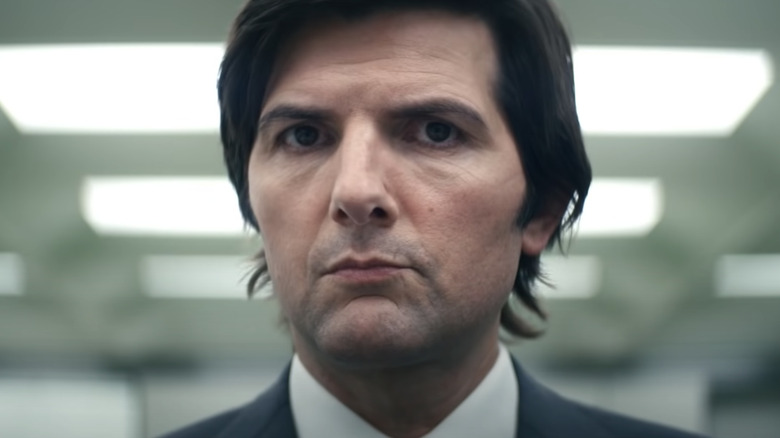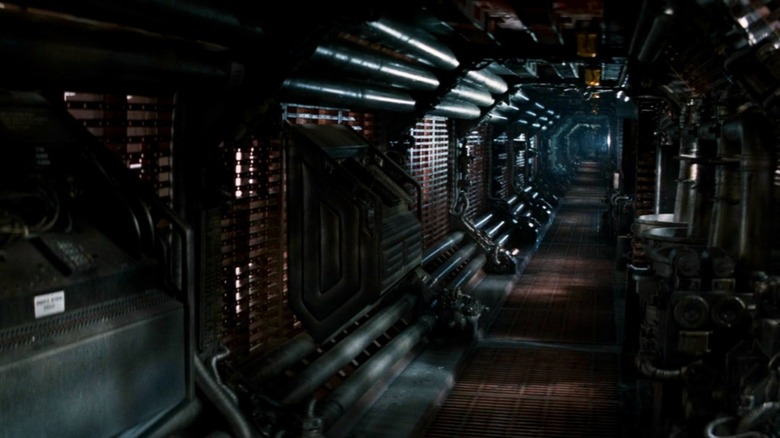Severance's Office Design Was Inspired By A Classic Sci-Fi Film
"Severance," the acclaimed Apple TV+ series starring Adam Scott, has drawn comparisons to "Lost" for its elaborate, mythology-driven, mystery-box storytelling — "the beginning of a long answer," as one character describes it. However, the show itself, which uses an office floor as its main setting, drew inspiration from an older sci-fi horror classic set on a spaceship.
Think of it as a "haunted house movie in [office] space." That might give you a hint as to what specific film influenced "Severance."
In an interview with The Verge, production designer Jeremy Hindle revealed that the spaceship Nostromo in Ridley Scott's "Alien" helped inspire the self-contained, subterranean office world of "Severance." "It's not a spaceship, but it is a spaceship," Hindle said. "Alien" has often been described as a "haunted house movie in space," where the characters are trapped on board with an acid-blooded, extraterrestrial killing machine instead of a garden-variety ghost.
Scott's film, which featured hall-of-fame production design by Michael Seymour, takes time at the beginning to orient the viewer to the Nostromo and its empty passageways, as if the ship and the setting is the main character. It's only after five minutes that a door slides open and a camera glides through it, to a room where the lights go up to reveal cryogenically frozen people in hypersleep chambers.
"Severance," too, displays images of a huge, empty parking lot and cavernous office building, and it's easy to see how Hindle might look to a movie like "Alien" while designing the production space for a show about office workers whose memories and very selves are hibernating, as if in the suspended animation of hypersleep.
'I used to think it would take a monster...'
The basic premise of "Severance" is that people give consent to have their memories between the office and home severed, theoretically achieving a better work/life balance. In the same way that "Alien" had its terrifying Xenomorph pick off crew members one by one, Scott's "Severance" protagonist, Mark, sees his clean-shaven best friend and co-worker, Petey (Yul Vazquez), go missing, which leads to a job promotion for him as he takes over Petey's position. Later, when a visibly changed, more unkempt Petey catches up with an amnesiac Mark outside work, he says, "I used to think it would take a monster to put someone in a place like that office, especially if the person was himself."
"Every time you find yourself here, it's because you chose to come back." These words kicked off the trailer for "Severance" as a kind of thematic statement. They seemed to position it as a show where the monsters were inside us, resigning us to a fate less than what we deserved, perhaps in the form of a soul-sucking job.
Another major influence on "Severance" was the 1967 French comedy "Playtime," renowned for its gigantic set. This is something that came up in our own interview with Hindle, where he mentioned director Ben Stiller and said:
"Ben and I had this same reference at the beginning, which was the movie 'Playtime.' It's a '60s French film by Jacques Tati, and the design is really fun."
Hindle also likened "Severance" to "Twin Peaks." It's clear that he was pulling inspiration from numerous sources as he set about creating the surreal "Severance" office.
For many people working remotely from home, the pandemic has blurred the boundaries between our personal and professional lives more than ever. It's not always easy to clock out when you still have incoming messages or work to do. The "Alien" movies showed a grimy future that was light years from our own, but the dystopian vision of "Severance" and its production design serve as a bridge back to recognizable reality, which is sometimes very scary.

